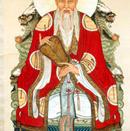There is no single definition of Taoism in the Tao de Ching. The reader realizes that she will not find one in the text after seeing the first sentence. By saying that whatever can be described of the Tao is not the true Tao, its author, Lao-tzu, establishes his first premise: the Tao is a force beyond human explanation. However this assumption does not mean that he can't attempt to describe it. Using the literary tools of contradiction, parallel structure, and metaphor, Lao-tzu discusses the Tao in language regular people can understand.
Contradiction
In the beginning the Tao gave birth to both good and evil (Ch 5) and along with that came all of the other pairs. In Chapter 36 Lao-tzu discusses action and reaction,
'If you want to shrink something,
you must first allow it to expand.
If you want to get rid of something,
you must first allow it to flourish.
If you want to take something,
you must first allow it to be given.'
This excerpt ties into the statement in Chapter 30 that 'for every force there is a counter force' which is applicable to political situations. For example, if a ruler noticed an uprising of disgruntled subjects, it would be wise of her to let them organize, or expand, and state their grievances as a whole before she individually addressed their complaints.
Lao-tzu also uses contradiction in Ch 22,
'If you want to become whole,
let yourself be partial.
If you want to become strait,
let yourself be crooked.
If you want to become full,
let yourself be empty.
If you want to be reborn,
let yourself die...'
In other words, if a person wants to succeed she must first understand the opposition. This strategy is used often in war. In order to...



A Philosophy for all- an analysis of the Tao
Great explanation about the Tao and addressed all contradictions as well.
0 out of 0 people found this comment useful.